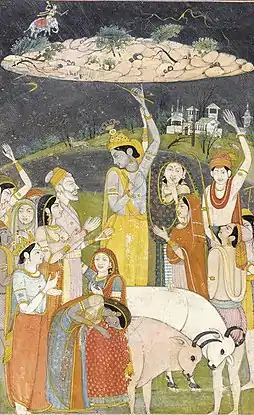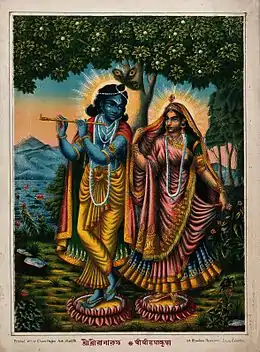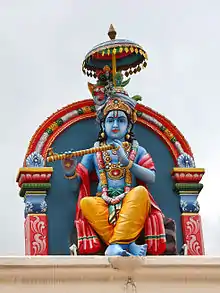Krishnaism
Krishnaism (IAST: Kṛṣṇaism) is a large group of independent Hindu traditions—sampradayas related to Vaishnavism—that center on the devotion to Krishna as Svayam Bhagavan, Parabrahman, the source of all reality, who is not an avatar of Vishnu.[1] This is its difference from such Vaishnavite groupings as Sri Vaishnavism, Ramaism, Radhaism, Sitaism, etc.[2]
| Part of a series on |
| Vaishnavism |
|---|
 |
|
|
Krishnaism originated in the late centuries BCE from the followers of the heroic Vāsudeva Krishna, which amalgamated several centuries later, in the early centuries CE, with the worshipers of the "divine child" Bala Krishna and the Gopala-Krishna traditions of monotheistic Bhagavatism. These non-Vedic traditions in Mahabharata canon affiliate itself with ritualistic Vedism in order to become acceptable to the orthodox establishment. Krishnaism becomes associated with bhakti yoga and bhakti movement in the Medieval period.
The most remarkable Hindu scriptures for the Krishnaits became Bhagavad Gita, Harivamsa (appendix to the Mahabharata), and Bhagavata Purana.
History
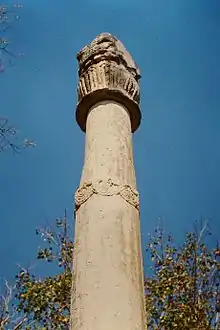
Krishnaism originates in the early centuries CE, initially focusing on the worship of the heroic Vāsudeva Krishna in the region of Mathura, the "divine child" Bala Krishna and Gopala-Krishna.[3][note 1] It is closely related to, and find its origin in, Bhagavatism.[5]

Krishnaism is a non-Vedic tradition in origin, but it further developed its appeal towards orthodox believers through the syncretism of these traditions with the Mahabharata epic. In particular Krishnaism incorporated more or less superficially the Vedic supreme deity Vishnu, who appears in the Rigveda.[note 2] Krishnaism further becomes associated with bhakti yoga in the Medieval period.
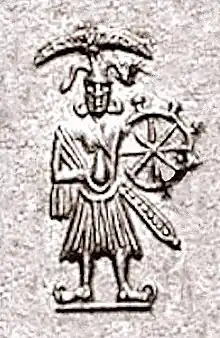
Northern India
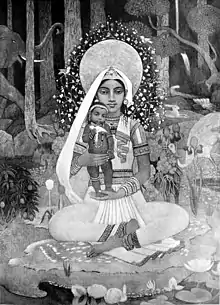
Early Krishnaism started with the cult of the heroic Vasudeva Krishna,[10][11] which, several centuries later, was amalgamated with the cult of the "divine child" Bala Krishna and the Gopala traditions.[12] While Vishnu is attested already in the Rigveda, the development of Krishnaism appears to take place via the worship of Vasudeva in the final centuries BCE. This earliest phase was established the time of Pāṇini (4th century BCE) who, in his Astadhyayi, explained the word vasudevaka as a bhakta (devotee) of Vasudeva.[13][14][15][16] At that time, Vāsudeva was already considered as a demi-God, as he appears in Pāṇini's writings in conjunction with Arjuna as an object of worship, since Pāṇini explains that a vāsudevaka is a devotee (bhakta) of Vāsudeva.[14][17][18]
A sect which flourished with the decline of Vedism was centred on Krishna, the deified tribal hero and religious leader of the Yadavas.[19] Worship of Krishna, the deified tribal hero and religious leader of the Yadavas, took sectarian form as the Pancaratra and earlier as Bhagavata religions. This sect has at a later stage merged with the sect of Narayana.[5]
The character of Gopala Krishna is often considered to be non-Vedic.[20]
By the time of its incorporation into the Mahabharata canon during the early centuries CE, Krishnaism began to affiliate itself with Vedism in order to become acceptable to orthodoxy, in particular aligning itself with Rigvedic Vishnu.[4] At this stage that Vishnu of the Rig Veda was assimilated into Krishnaism and became the equivalent of the Supreme God.[19] The appearance of Krishna as one of the Avatars of Vishnu dates to the period of the Sanskrit epics in the early centuries CE. The Bhagavad Gita was incorporated into the Mahabharata as a key text for Krishnaism.[21]
Southern India
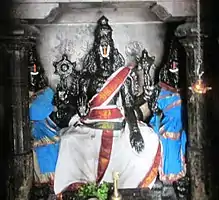
According to Friedhelm Hardy,[note 3] there is evidence of early "southern Krishnaism," despite the tendency to allocate the Krishna-traditions to the Northern traditions.[22] South Indian texts show close parallel with the Sanskrit traditions of Krishna and his gopi companions, so ubiquitous in later North Indian text and imagery.[24] Early writings in Dravidian culture such as Manimekalai and the Cilappatikaram present Krishna, his brother, and favourite female companions in the similar terms.[24] Hardy argues that the Sanskrit Bhagavata Purana is essentially a Sanskrit "translation" of the bhakti of the Tamil alvars.[25]
Devotion to southern Indian Mal (Thirumal) may be an early form of Krishnaism, since Mal appears as a divine figure, largely like Krishna with some elements of Vishnu.[26] The alvars, whose name can be translated "sages" or "saints", were devotees of Mal. Their poems show a pronounced orientation to the Vaishnava, and often Krishna, side of Mal. But they do not make the distinction between Krishna and Vishnu on the basis of the concept of the avatars.[26] Yet, according to Hardy the term "Mayonism" should be used instead of "Krishnaism" when referring to Mal or Mayon.[22]
Early medieval traditions
By the Early Medieval period, Krishnaism had risen to a major current of Vaishnavism.[4]
Vaishnavism in the 8th century came into contact with the Advaita doctrine of Adi Shankara. Vasudeva has been interpreted by Adi Shankara, using the earlier Vishnu Purana as a support, as meaning the "supreme self" or Vishnu, dwelling everywhere and in all things,[27] although many other schools of Hindu philosophy have a different interpretation of this key concept. There were counter-movements in South India to Shankara's theory of Brahman in particular, Ramanuja in the 11th century and Madhva in the 13th, building on the devotional tradition of the alvars (Shri Vaishnavas).
High and late medieval traditions
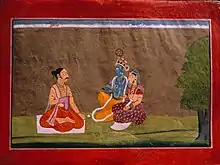
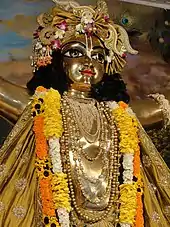
The Bhakti movement of high and late medieval Hinduism emerges in the 9th or 10th century, and is based on the Bhagavata Purana, Narada Bhakti Sutra, and other scriptures. In North India, Krishnaism gave rise to various late Medieval movements. Early Bhakti Krishnaite pioneers include the Telugu-origin philosopher Nimbarkacharya (12th or 13th century CE) and his friend, poet from Odisha Jayadeva, an author of Gitagovinda. Both promote Radha Krishna to be the supreme lord while the ten incarnations are his forms.[2][28][29] Since 15th century in Bengal and Assam flourished Tantric variaty of Krishnaism—Vaishnava-Sahajiya of Bengali poet Chandidas—where Krishna is the inner divine aspect of man and Radha is the aspect of woman.[30]
The most emerged guru 15th–16th centuries—Telugu by origin Vallabhacharya, Sankardev in Assam, and Chaitanya Mahaprabhu in Bengal. They started their own schools, namely Nimbarka Sampradaya (a.k.a. Kumara sampradaya, the first),[31] Pushtimarg sampradaya,[32] Gaudiya Vaishnavism (a.k.a. Chaitanya sampradaya, including Manipuri Vaishnavism),[33] with Krishna and his consort/shakti Radha as the supreme god,[note 4][note 5] [note 6][37][38] and Ekasarana Dharma by Sankardev without Radha[39]
In the Deccan, particularly in Maharashtra, saint poets of the Warkari tradition such as Dnyaneshwar, Namdev, Janabai, Eknath, and Tukaram promoted the worship of Vithoba, a local form of Krishna, from the beginning of the 13th century until the late 18th century.[40] Before the Warkari sampradaya, Krishna devotion (Pancha-Krishna) became well established in Maharashtra due to the rise of Mahanubhava Panth founded by 13th-century Gujarati-Marathi acharya Chakradhara.[41]
19th–21st centuries traditions
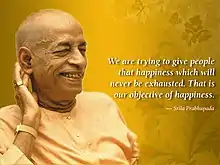
The cult of Krishna later evolved in modern times by Swaminarayan, the founder of the Swaminarayan Sampradaya in early 19th century, also worshipped Krishna as God himself (see his Shikshapatri),[42]
Within Gaudiya Vaishnavism in 20th century was establushed the reform Gaudiya Math and its worldwide successor, the International Society for Krishna Consciousness (a.k.a. Hare Krishna Movement), founded by A. C. Bhaktivedanta Swami Prabhupada.[2]
There is the number of neo-Hindu Krishnaite organisations only partially related to traditional sampradayas, such as Jagadguru Kripalu Parishat, Jagadguru Kripaluji Yog, and Science of Identity Foundation.
Beliefs
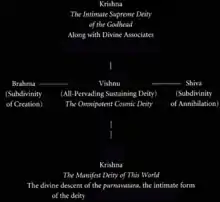
Krishnaism and Vaishnavism
The term "Krishnaism" has been used to describe the sects focused on Krishna, while "Vishnuism/Vaishnavism" may be used for sects focusing on Vishnu in which Krishna is an avatar, rather than a transcended Supreme Being.[43][44] Vishnuism believes in Vishnu as the supreme being, manifested himself as Krishna, while Krishnaism asserts Krishna to be Svayam Bhagavan (Sanskrit: "The Fortunate and Blessed One Himself"), the Para Brahman in human form,[45] that manifested himself as Vishnu. As such Krishnaism is believed to be one of the early attempts to make philosophical Hinduism appealing to the masses.[46] In common language the term Krishnaism is not often used, as many prefer a wider term "Vaishnavism", which appeared to relate to Vishnu, more specifically as Vishnu-ism.
Krishnaism is often also called Bhagavatism, after the Bhagavata Purana which asserts that Krishna is "Bhagavan Himself," and subordinates to itself all other forms: Vishnu, Narayana, Purusha, Ishvara, Hari, Vasudeva, Janardana, etc.[note 7]
Krishna
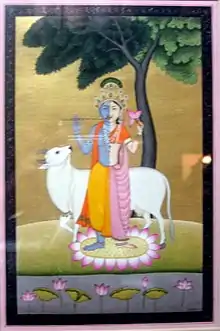
Vaishnavism is a monotheistic religion, centered on the devotion of Vishnu and his avatars. It is sometimes described as a"polymorphic monotheism", since there are many forms of one original deity, with Vishnu taking many forms. In Krishnaism this deity is Krishna, sometimes referred as intimate deity - as compared with the numerous four-armed forms of Narayana or Vishnu.[48]
Krishna is also worshiped across many other traditions of Hinduism. Krishna is often described as having the appearance of a dark-skinned person and is depicted as a young cowherd boy playing a flute or as a youthful prince giving philosophical direction and guidance, as in the Bhagavad Gita.[49]
Krishna and the stories associated with him appear across a broad spectrum of different Hindu philosophical and theological traditions, where it is believed that God appears to his devoted worshippers in many different forms, depending on their particular desires. These forms include the different avataras of Krishna described in traditional Vaishnava texts, but they are not limited to these. Indeed, it is said that the different expansions of the Svayam bhagavan are uncountable and they cannot be fully described in the finite scriptures of any one religious community.[50][51] Many of the Hindu scriptures sometimes differ in details reflecting the concerns of a particular tradition, while some core features of the view on Krishna are shared by all.[52]
Common scriptures
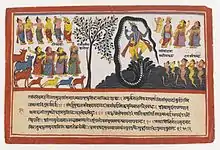
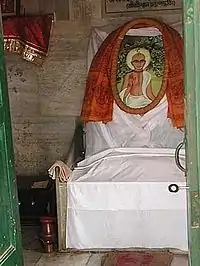
The most remarkable Hindu scriptures for the Krishnaits became Bhagavad Gita,[54][55] Harivamsa (appendix to the Mahabharata),[56] and Bhagavata Purana (especially 10th Book).[57][58][59][60] While every tradition of Krishnaism has its own canon, in all Krishna is accepted as a teacher of the path in the scriptures Bhagavad Gita and the Bhagavata Purana.[61][62][63][note 8]
As Krishna says in the Bhagavad Gita, establishing the basis of Krishnaism himself:
- "And of all yogins, he who full of faith worships Me, with his inner self abiding in Me, him, I hold to be the most attuned (to me in Yoga)."[65]
- "After attaining Me, the great souls do not incur rebirth in this miserable transitory world, because they have attained the highest perfection."[66]
In Gaudiya Vaishnava, Vallabha Sampradaya, Nimbarka sampradaya and the old Bhagavat school, Krishna is believed to be fully represented in his original form in the Bhagavata Purana, that at the end of the list of avataras concludes with the following assertion:[67]
All of the above-mentioned incarnations are either plenary portions or portions of the plenary portions of the Lord, but Sri Krishna is the original Personality of Godhead (Svayam Bhagavan).[68]
Not all commentators on the Bhagavata Purana stress this verse, however a majority of Krishna-centered and contemporary commentaries highlight this verse as a significant statement.[69] Jiva Goswami has called it Paribhasa-sutra, the "thesis statement" upon which the entire book or even theology is based.[70][71]
In another place of the Bhagavata Purana (10.83.5-43) those who are named as wives of Krishna all explain to Uraupadi how the 'Lord himself' (Svayam Bhagavan, Bhagavata Purana 10.83.7) came to marry them. As they relate these episodes, several of the wives speak of themselves as Krishna's devotees.[72] In the tenth canto the Bhagavata Purana describes svayam bhagavans Krishna's childhood pastimes as that of a much-loved child raised by cowherds in Vrindavan, near to the Yamuna River. The young Krishna enjoys numerous pleasures, such as thieving balls of butter or playing in the forest with his cowherd friends. He also endures episodes of carefree bravery protecting the town from demons. More importantly, however, he steals the hearts of the cowherd girls (Gopis). Through his magical ways, he multiplies himself to give each the attention needed to allow her to be so much in love with Krishna that she feels at one with him and only desires to serve him. This love, represented by the grief they feel when Krishna is called away on a heroic mission and their intense longing for him, is presented as models of the way of extreme devotion (bhakti) to the Supreme Lord.[73]
Edwin F. Bryant describes the synthesis of ideas in Bhagavata Purana 10th Book as:
The tenth book promotes Krishna as the highest absolute personal aspect of godhead — the personality behind the term Ishvara and the ultimate aspect of Brahman.[74]
- Other common scriptures
- Brahma Vaivarta Purana is one of major Puranas, that centers around Krishna and Radha, identifying Krishna as the Supreme Being and asserting that all deities such as Vishnu, Shiva, Brahma, Ganesha are incarnations of Him;
- Gitagovinda is a poem of Jayadeva that firstly considers the cult Radha Krishna;
- Narayaniyam is Melpathur Narayana Bhattathiri's poem as a summary of the Bhagavata Purana.
Practics
Maha-mantra
.png.webp)
A mantra is a sacred utterance. The most basic and known it among the Krishnaits—Mahā-mantra ("Great Mantra")—is a 16-word mantra in Sanskrit which is mentioned in the Kali-Saṇṭāraṇa Upaniṣad:[75][76]
Hare Rāma Hare Rāma
Rāma Rāma Hare Hare
Hare Kṛṣṇa Hare Kṛṣṇa
Kṛṣṇa Kṛṣṇa Hare Hare— Kali-Saṇṭāraṇa Upaniṣad
Its variaty within Gaudiya Vaishnavism looks as:
Hare Kṛṣṇa Hare Kṛṣṇa
Kṛṣṇa Kṛṣṇa Hare Hare
Hare Rāma Hare Rāma
Rāma Rāma Hare Hare
The Maha-mantra Radhe Krishna of Nimbarka Sampradaya is as follows:
Rādhe Kṛṣṇa Rādhe Kṛṣṇa
Kṛṣṇa Kṛṣṇa Rādhe Rādhe
Rādhe Shyām Rādhe Shyām
Shyām Shyām Rādhe Rādhe
Holy places

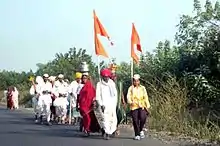
Vrindavana, Uttar Pradesh, is often considered to be a holy place by majority of traditions of Krishnaism. It's a center of Krishna worship and the area includes places like Govardhana and Gokula associated with Krishna from time immemorial. Many millions of bhaktas or devotees of Krishna visit these places of pilgrimage every year and participate in a number of festivals that relate to the scenes from Krishna's life on Earth.[64]
On the other hand, Goloka is considered the eternal abode of Krishna, Svayam Bhagavan according to some Vaishnavite schools, including Gaudiya Vaishnavism and the Swaminarayan Sampradaya. The scriptural basis for this is taken in Brahma Samhita and Bhagavata Purana.[78]
Contemporary Krishnaite traditions
|
Radha Krishna as the Supreme
|
Krishna as the Supreme
|
Other Krishna's forms as the Supreme
|
Such offshoot of Krishnaism as Radha-centric Radha-vallabha sampradaya is a part of another Vaishnavite stream, the so-called Radhaism.[2]
Demography
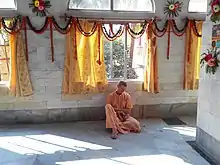
Krishnaism has a limited following outside of India, especially associated with 1960s counter-culture, including a number of celebrity followers, such as George Harrison, due to its promulgation throughout the world by the founder-acharya of the International Society for Krishna Consciousness (ISKCON) A.C. Bhaktivedanta Swami Prabhupada.[79][80][81] The first Hindu member of the United States Congress Tulsi Gabbard is follower of the Krishnaite organisation Science of Identity Foundation.[82][83]
Krishnaism and Christianity
Debaters have often alleged a number of parallels between Krishnaism and Christianity, originating with Kersey Graves' The World's Sixteen Crucified Saviors claiming 346 parallels between Krishna and Jesus,[84] theorizing that Christianity emerged as a result of an import of pagan concepts upon Judaism. Some 19th- to early 20th-century scholars writing on Jesus Christ in comparative mythology (John M. Robertson, Christianity and Mythology, 1910) even sought to derive both traditions from a common predecessor religion.[note 9]
Gallery of Krishnaite temples
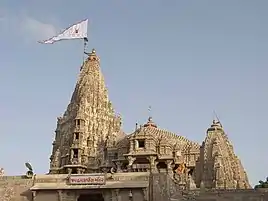 Dwarkadhish Temple, Dwarka, Gujarat
Dwarkadhish Temple, Dwarka, Gujarat.jpg.webp) Ningthoukhong Gopinath Temple, Manipur
Ningthoukhong Gopinath Temple, Manipur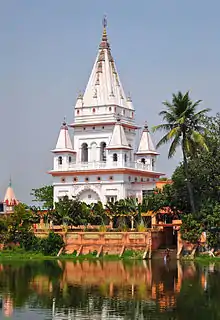 Yogapith Temple, Mayapur
Yogapith Temple, Mayapur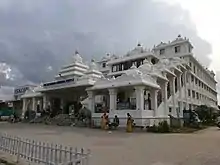
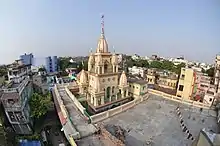 Gour Nitai Temple, Gaudiya Math, Kolkata
Gour Nitai Temple, Gaudiya Math, Kolkata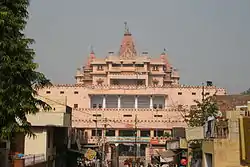

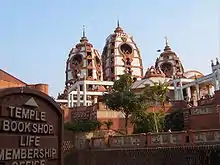

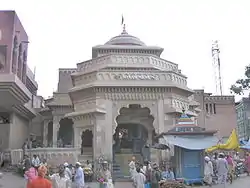 Vithoba Temple, Maharashtra
Vithoba Temple, Maharashtra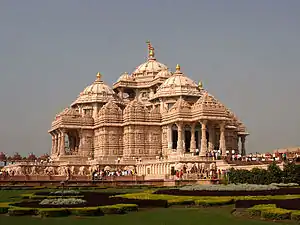
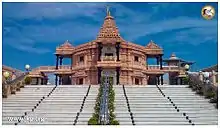
Notes
- "Present day Krishna worship is an amalgam of various elements. According to historical testimonies Krishna-Vāsudeva worship already flourished in and around Mathura several centuries before Christ. A second important element is the cult of Krishna Govinda. Still later is the worship of Bala-Krishna, the Divine Child Krishna — a quite prominent feature of modern Krishnaism. The last element seems to have been Krishna Gopijanavallabha, Krishna the lover of the Gopis, among whom Radha occupies a special position. In some books Krishna is presented as the founder and first teacher of the Bhagavata religion."[4]
- "Non-Vedic in origin and development, Kṛṣṇaism now sought affiliation with Vedism so that it could become acceptable to the still not inconsiderable orthodox elements among the people. That is how Viṣṇu of the Ṛgveda came to be assimilated—more or less superficially—into Kṛṣṇaism."[6]
- Friedhelm Hardy in his "Viraha-bhakti" analyses the history of Krishnaism, specifically all pre-11th-century sources starting with the stories of Krishna and the gopi, and Mayon mysticism of the Vaishnava Tamil saints, Sangam Tamil literature and Alvars' Krishna-centered devotion in the rasa of the emotional union and the dating and history of the Bhagavata Purana.[22][23]
- "(...) After attaining to fame eternal, he again took up his real nature as Brahman. The most important among Visnu's avataras is undoubtedly Krsna, the black one, also called Syama. For his worshippers he is not an avatara in the usual sense, but Svayam Bhagavan, the Lord himself."[34]
- "On the touch-stone of this definition of the final and positive characteristic of Sri Krsna as the Highest Divinity as Svayam-rupa Bhagavan."[35]
- "The Bengal School identifies the Bhagavat with Krishna depicted in the Shrimad-Bhagavata and presents him as its highest personal God."[36]
- "It becomes clear that the personality of Bhagvan Krishna subordinates to itself the titles and identities of Vishnu, Narayana, Purusha, Ishvara, Hari, Vasudeva, Janardana etc. The pervasive theme, then, of the Bhagavata Puran is the identification of Bhagavan with Krishna."[47]
- "..Bhagavad Gita and the Bhagavata Purana, certainly the most popular religious books in the whole of India. Not only was Krsnaism influenced by the identification of Krsna with Vishnu, but also Vaishnavism as a whole was partly transformed and reinvented in the light of the popular and powerful Krishna religion. Bhagavatism may have brought an element of cosmic religion into Krishna worship; Krishna has certainly brought a strongly human element into Bhagavatism. ... The center of Krishna-worship has been for a long time Brajbhumi, the district of Mathura that embraces also Vrindavana, Govardhana, and Gokula, associated with Krishna from the time immemorial. Many millions of Krishna bhaktas visit these places ever year and participate in the numerous festivals that reenact scenes from Krshnas life on Earth."[64]
- "John M. Robertson wrote a learned treatise entitled "Christ and Krishna", and in that work he argued that there was no direct contact between Krishnaism and Christianity; but that both sects were derived from an earlier common source."[85]
References
- Mullick 1898; Hardy 1987, pp. 387–392; Flood 1996, p. 117; Matchett 2001; Bryant 2007, p. 381.
- Hardy 1987, pp. 387–392.
- Basham 1968, pp. 667-670.
- Klostermaier 2005, p. 206.
- Welbon 1987.
- Eliade, Mircea, ed. (1987). The Encyclopedia of religion. 15. MacMillan. p. 170.
- Singh, Upinder (2008). A History of Ancient and Early Medieval India: From the Stone Age to the 12th Century. Pearson Education India. p. 436–438. ISBN 978-81-317-1120-0.
- Osmund Bopearachchi, Emergence of Viṣṇu and Śiva Images in India: Numismatic and Sculptural Evidence, 2016.
- Srinivasan, Doris (1997). Many Heads, Arms, and Eyes: Origin, Meaning, and Form of Multiplicity in Indian Art. Brill. p. 215. ISBN 978-90-04-10758-8.
- Hudson 1993.
- Bryant 2007, p. 4.
- Hein 1986, pp. 296–317.
- Goswami 1956.
- Flood 1996, pp. 119–120.
- Doris Srinivasan (1997). Many Heads, Arms, and Eyes: Origin, Meaning, and Form of Multiplicity in Indian Art. Brill Academic. pp. 211–220, 236. ISBN 90-04-10758-4.
- Christopher Austin (2018). Diana Dimitrova and Tatiana Oranskaia (ed.). Divinizing in South Asian Traditions. Taylor & Francis. pp. 30–35. ISBN 978-1-351-12360-0.
- Malpan, Varghese (1992). A Comparative Study of the Bhagavad-gītā and the Spiritual Exercises of Saint Ignatius of Loyola on the Process of Spiritual Liberation. Gregorian Biblical BookShop. pp. 57–58. ISBN 978-88-7652-648-0.
- "The affix vun comes in the sense of "this is his object of veneration" after the words 'Vâsudeva' and 'Arjuna'", giving Vâsudevaka and Arjunaka. Source: Aṣṭādhyāyī 2.0 Panini 4-3-98
- "Vaishnava". philtar.ucsm.ac.uk. Archived from the original on 12 February 2012. Retrieved 22 May 2008.
- Ramkrishna Gopal Bhandarkar, Ramchandra Narayan Dandekar (1976). Ramakrishna Gopal Bhandarkar as an Indologist: A Symposium. India: Bhandarkar Oriental Research Institute. pp. 38–40.
- G. Widengren (1997). Historia Religionum: Handbook for the History of Religions - Religions of the Present. Boston: Brill Academic Publishers. p. 270. ISBN 90-04-02598-7.
- Hardy 2001.
- "Book review: Friedhelm Hardy, Viraha Bhakti: The Early History of Krishna Devotion in South India. Oxford University Press, Nagaswamy 23 (4): 443 — Indian Economic & Social History Review". ier.sagepub.com. Retrieved 29 July 2008.
- Monius, Anne E. "Dance Before Doom. Krishna In The Non-Hindu Literature of Early Medieval South India" in Beck 2005, p. 139-149
- Norman Cutler (1987) Songs of Experience: The Poetics of Tamil Devotion, p. 13
- "Devotion to Mal (Mayon)". philtar.ucsm.ac.uk. Archived from the original on 5 February 2012. Retrieved 22 May 2008.
- Ganguli translation of Mahabharata, Ch.148
- Vemsani 2016, p. 197.
- Nimbarka, Encyclopaedia Britannica Online
- Basu 1932; Dasgupta 1962; Das 1988; Hine 2003.
- Hardy 1987, pp. 387–392; Clémentin-Ojha 1990, pp. 327–376; Vemsani 2016, p. 197.
- Redington 1992, pp. 287–294; Patel 2005, pp. 127–136.
- De 1960; Elkman 1986; Rosen 1994; Chatterjee 1995, pp. 1–14; Gupta 2007.
- Klostermaier, Klaus K. (1997). The Charles Strong Trust Lectures, 1972–1984. Crotty, Robert B. Brill. p. 109. ISBN 978-90-04-07863-5.
- Indian Philosophy & Culture. 20. Institute of Oriental Philosophy (Vrindāvan, India), Institute of Oriental Philosophy, Vaishnava Research Institute, contributors. The Institute. 1975. p. 148.CS1 maint: others (link)
- De 1960, p. 113.
- Kennedy 1925.
- McDaniel, June. "Folk Vaishnavism and Ṭhākur Pañcāyat: Life and status among village Krishna statues" in Beck 2005, p. 39
- Murthy 1973; Neog 1980; Bryant 2007, chapter 6.
- Iwao 1988, pp. 183–197; Glushkova 2000, pp. 47–58.
- Feldhaus 1983.
- "Shikshapatri, verse 109 by Bhagwan Swaminarayan". Archived from the original on 5 February 2012.
- Flood 1996, p. 117.
- Matchett 2001.
- Bryant 2007, p. 309.
- Wilson, Bill; McDowell, Josh (1993). The best of Josh McDowell: a ready defense. Nashville: T. Nelson. pp. 352–353. ISBN 0-8407-4419-6.CS1 maint: multiple names: authors list (link)
- Sheridan 1986, p. 53.
- Scheweig 2004, pp. 13-17
- Elkman 1986.
- "Chaitanya Charitamrita Madhya 20.165". Archived from the original on 17 September 2008. Retrieved 22 May 2008.
- Richard Thompson, Ph. D. (December 1994). "Reflections on the Relation Between Religion and Modern Rationalism". Archived from the original on 4 January 2011. Retrieved 12 April 2008. Cite journal requires
|journal=(help) - Mahony, W.K. (1987). "Perspectives on Krsna's Various Personalities". History of Religions. 26 (3): 333–335. doi:10.1086/463085. JSTOR 1062381. S2CID 164194548.
- Gupta 2007.
- Bryant 2007, Chapter 2.
- Rosen 2007.
- Bryant 2007, Chapter 3.
- Vaudeville 1962, pp. 31–40.
- Miller 1975, pp. 655–671.
- Bryant 2003.
- Bryant 2007, Chapter 4.
- James Mulhern (1959) A History of Education: A Social Interpretation p. 93
- Franklin Edgerton (1925) The Bhagavad Gita: Or, Song of the Blessed One, India's Favorite Bible pp. 87-91
- Charlotte Vaudeville has said, it is the 'real Bible of Krsnaism'. Quoted in: Matchett, 2000
- Klostermaier 2005, p. 204.
- Radhakrishan(1970), ninth edition, Blackie and son India Ltd., p.211, Verse 6.47
- A. C. Bhaktivedanta Swami Prabhupada. "Bhaktivedanta VedaBase: Bhagavad-gita As It Is, Verse 8.15". Bhaktivedanta VedaBase Network (ISKCON). Retrieved 14 January 2008.
- Matchett 2000, p. 153Bhag. Purana 1.3.28 :ete cāṁśa-kalāḥ puṁsaḥ kṛṣṇas tu bhagavān svayam :indrāri-vyākulaṁ lokaṁ mṛḍayanti yuge yuge
- 1.3.28 Swami Prabhupada, A.C. Bhaktivedanta. "Srimad Bhagavatam Canto 1 Chapter 3 Verse 28". Bhaktivedanta Book Trust. Retrieved 7 May 2008.
- "Sri Krishna". www.stephen-knapp.com. Retrieved 30 April 2008.
- Dhanurdhara Swami (2000). Waves of Devotion. Bhagavat Books. ISBN 0-9703581-0-5.
- "Waves of Devotion". www.wavesofdevotion.com. Archived from the original on 5 February 2012. Retrieved 4 May 2008. In Hari-namamr†a-vyakarana, Jiva Gosvami defines paribhasa-sutra as aniyame niyama-karini paribhasa: "A paribhasa-sutra implies a rule or theme where it is not explicitly stated." In other words, it gives the context in which to understand a series of apparently unrelated statements in a book.
- Matchett 2000, p. 141
- Matchett 2000, 10th canto transl.
- Bryant 2007, p. 114.
- Beck 1993, p. 199.
- "Contents of the Kali-Saṇṭāraṇa Upaniṣad". Retrieved 31 December 2019.
- Vemsani 2016, pp. 140–141.
- Schweig 2005, p. 10.
- Brooks 1989.
- Giuliano, Geoffrey (1997). Dark horse: the life and art of George Harrison. New York: Da Capo Press. p. 12. ISBN 0-306-80747-5.
- Schweig 2005.
- What Does Tulsi Gabbard Believe?, Kelefa Sanneh, The New Yorker, Oktober 30, 2017.
- Tulsi Gabbard Had a Very Strange Childhood, Kerry Howley, New York Intelligencer, Juni 11, 2019.
- The World's Sixteen Crucified Saviors by Kersey Graves
- Jackson, John (1985). Christianity Before Christ. American Atheist Press. pp. 166. ISBN 0-910309-20-5.
Bibliography
- Anand, D. (1992). Krishna: The Living God of Braj. New Delhi: Shakti Malik Abhinav Publ. ISBN 81-7017-280-2.
- Basham, Arthur Llewellyn (1968). "Review: Krishna: Myths, Rites, and Attitudes by Milton Singer; Daniel H. H. Ingalls". The Journal of Asian Studies. 27 (3): 667–670. doi:10.2307/2051211. JSTOR 2051211.
- Basu, M. M. (1932). The Post-Caitanya Sahajiya Cult of Bengal. Calcutta: University of Calcutta Press.
- Beck, Guy L. (1993). Sonic Theology: Hinduism and Sacred Sound. Studies in Comparative Religion. Columbia, SC: University of South Carolina Press. ISBN 0872498557.
- Beck, Guy L., ed. (2005). Alternative Krishnas: Regional and Vernacular Variations on a Hindu Deity. Albany, NY: SUNY Press. ISBN 978-0-7914-6415-1.
- Bhattacharya, Sunil Kumar (1996). Krishna-cult in Indian Art. New Delhi: M. D. Publ. Pvt. ISBN 81-7533-001-5.
- Brooks, Charles R. (1989). The Hare Krishnas in India. Princeton, NJ: Princeton University Press. ISBN 069100031X.
- Bryant, Edwin F. (2003). Krishna: The Beautiful Legend of God; Śrīmad Bhāgavata Purāṇa, Book X; with Chapters 1, 6 and 29–31 from Book XI. London: Penguin Classics. ISBN 0140447997.
- Bryant, Edwin F., ed. (2007). Krishna: A Sourcebook. New York: Oxford University Press. ISBN 978-0-19-514891-6.
- Brzezinski, J. K. (1992). "Prabodhananda, Hita Harivamsa and the Radharasasudhanidhi". Bulletin of the School of Oriental and African Studies, University of London. 55 (3): 472–497. doi:10.1017/S0041977X00003669. JSTOR 620194.
- Chatterjee, Asoke (1995). "Srimadbhagavata and Caitanya-Sampradaya". Journal of the Asiatic Society. 37 (4): 1–14.
- Clémentin-Ojha, Catherine (1990). "La renaissance du Nimbarka Sampradaya au XVIe siècle. Contribution à l'étude d'une secte Krsnaïte". Journal Asiatique (in French). 278: 327–376. doi:10.2143/JA.278.3.2011219.
- Couture, André (2006). The emergence of a group of four characters (Vasudeva, Samkarsana, Pradyumna, and Aniruddha) in the Harivamsa: points for consideration. Journal of Indian Philosophy 34,6. pp. 571-585.
- Das, Kalyani (1980). Early Inscriptions of Mathurā: A Study. Punthi Pustak.
- Das, Sri Paritosh (1988). Sahajiyā Cult of Bengal and Pancha Sakhā Cult of Orissa. Calcutta: Firma K.L. Mukhopadhyay.
- Dasgupta, Shashibhusan (1962) [1946]. Obscure Religious Cults as a Background to Bengali Literature (2nd rev. ed.). Calcutta: Firma K.L. Mukhopadhyay.
- De, Sushil Kumar (1960). Bengal's contribution to Sanskrit literature & studies in Bengal Vaisnavism. Indian studies, past & present. Calcutta: K.L. Mukhopadhyaya. OCLC 580601204.
- Elkman, Stuart Mark (1986). Jīva Gosvāmin's Tattvasandarbha: A Study on the Philosophical and Sectarian Development of the Gauḍīya Vaiṣṇava Movement. Delhi: Motilal Banarsidass. ISBN 8120801873.
- Feldhaus, Anne (1983). The religious system of the Mahānubhāva sect: the Mahānubhāva Sūtrapāṭha. South Asian studies, 12. New Delhi: Manohar. ISBN 9780836410051.
- Flood, Galvin D. (1996). An Introduction to Hinduism. Cambridge: Cambridge University Press. ISBN 978-0-521-43878-0. Archived from the original on 13 December 2000.
- Glushkova, Irina (2000). "Norms and Values in the Varkari Tradition". In Meera Kosambi (ed.). Intersections: Socio-cultural Trends in Maharashtra. New Delhi: Orient Longman. pp. 47–53. ISBN 81-250-1878-6.
- Goswami, Kunja Govinda (1956). A study of Vaiṣṇavism from the advent of the Sungas to the fall of the Guptas in the light of epigraphic, numismatic and other archaeological materials. Calcutta: Oriental Book Agency. ISBN 8120801873.
- Gupta, Ravi M. (2007). Caitanya Vaisnava Vedanta of Jiva Gosvami. Surrey: Routledge. ISBN 978-0-415-40548-5.
- Guy, John (1992). New evidence for the Jagannatha sect in seventeenth century Nepal. Journal of the Royal Asiatic Society [3rd Ser.] 2: 213-230.
- Hardy, Friedhelm E. (1987). "Kṛṣṇaism". In Mircea Eliade (ed.). The Encyclopedia of Religion. 8. New York: MacMillan. pp. 387–392. ISBN 978-0-02897-135-3.
- Hardy, Friedhelm E. (2001). Viraha-Bhakti: The Early History of Krsna Devotion in South India. Oxford University South Asian Studies Series. New York: Oxford University Press. ISBN 0-19-564916-8.
- Hawley, John Stratton (2006). Three Bhakti Voices. Mirabai, Surdas, and Kabir in Their Time and Ours. 2nd impression. Oxford.
- Hein, Norvin (1986). "A Revolution in Kṛṣṇaism: The Cult of Gopāla". History of Religions. 25 (4): 296–317. doi:10.1086/463051. JSTOR 1062622. S2CID 162049250.
- Hine, Phil (2003). "For the Love of God: Variations of the Vaisnava School of Krishna Devotion". Ashé Journal. 2 (4).
- Hudson, D. (1983). "Vasudeva Krsna in Theology and Architecture: A Background to Srivaisnavism". Journal of Vaisnava Studies (2).
- Iwao, Shima (June–September 1988). "The Vithoba Faith of Maharashtra: The Vithoba Temple of Pandharpur and Its Mythological Structure" (PDF). Japanese Journal of Religious Studies. Nanzan Institute for Religion and Culture. 15 (2–3): 183–197. ISSN 0304-1042. Archived from the original (PDF) on 26 March 2009.
- Kennedy, M. T. (1925). The Chaitanya Movement: A Study of the Vaishnavism of Bengal. H. Milford; Oxford University Press.
- Klostermaier, Klaus K. (2005). A Survey of Hinduism (3rd ed.). Albany, NY: SUNY Press. ISBN 0-7914-7081-4.
- Matchett, Freda (2001). Krsna, Lord or Avatara? the relationship between Krsna and Visnu: in the context of the Avatara myth as presented by the Harivamsa, the Visnupurana and the Bhagavatapurana. Surrey: Routledge. ISBN 0-7007-1281-X.
- Miller, S. B. S. (1975). "Radha: Consort of Krsna's Vernal Passion". Journal of the American Oriental Society. 95 (4): 655–671. doi:10.2307/601022. JSTOR 601022.
- Mishra, Baba (1999). "Radha and her contour in Orissan culture" in Orissan history, culture and archaeology. In Felicitation of Prof. P.K. Mishra. Ed. by S. Pradhan. (Reconstructing Indian History & Culture 16). New Delhi; pp. 243–259.
- Mullick, Bulloram (1898). Krishna and Krishnaism. Calcutta: S.K. Lahiri & Co.
- Murthy, H.V. Sreenivasa (1973). Vaisnavism of Samkaradeva and Ramanuja: A Comparative Study. Delhi: Motilal Banarsidass.
- Nash, J. (2012). "Re-examining Ecological Aspects of Vrindavan Pilgrimage". In L. Manderson; W. Smith; M. Tomlinson (eds.). Flows of Faith. Dordrecht: Springer. pp. 105–121. doi:10.1007/978-94-007-2932-2_7. ISBN 978-94-007-2931-5.
- Neog, Maheshwar (1980). Early History of the Vaishnava Faith and Movement in Assam. Delhi: Motilal Banarsidass.
- Patel, Gautam E. (2005). "Concept of God According to Vallabhacarya". In Ramkaran Sharma (ed.). Encyclopaedia of Indian Wisdom. 2. New Delhi; Varanasi: MacMillan. pp. 127–136.
- Pauwels, Heidi: Paradise Found, Paradise Lost: Hariram Vyas's Love for Vrindaban and what Hagiographers made of it. In Pilgrims, Patrons, and Place: Localizing Sanctity in Asian Religions. Ed. by Phyllis Granoff and Koichi Shinohara. (Asian Religions and Society Series). Vancouver, Toronto 2003; pp. 124–180.
- Redington, James D. (1992). "Elements of a Vallabhite Bhakti-synthesis". Journal of the American Oriental Society. 112: 287–294. doi:10.2307/603707. JSTOR 603707.
- Rosen, Steven J. (1994). Vaiṣṇavism: Contemporary Scholars Discuss the Gauḍīya Tradition. Foreword by E. C. Dimock (2nd ed.). Delhi: Motilal Banarsidass. ISBN 8120812352.
- Rosen, Steven J. (2007). Krishna's Song: A New Look at the Bhagavad Gita. Greenwood Publishing Group. ISBN 978-0313345531.
- Rosenstein, Ludmila L. (1997). The Devotional Poetry of Svami Haridas. A Study of Early Braj Bhasa Verse. (Groningen Oriental Studies, 12). Groningen.
- Schweig, Graham M. (2005). Dance of Divine Love: The Rڄasa Lڄilڄa of Krishna from the Bhڄagavata Purڄa. na, India's classic sacred love story. Princeton, NJ: Princeton University Press. ISBN 0-691-11446-3.
- Sheridan, Daniel (1986). The Advaitic Theism of the Bhāgavata Purāṇa. Delhi: Motilal Banarsidass.
- Singer, M. (1966). Krishna: Myths, Rites, and Attitudes. Honolulu: East-West Center Press.
- Sinha, K.P. (1997). A critique of A.C. Bhaktivedanta. Calcutta.
- Vaudeville, Ch. (1962). "Evolution of Love-Symbolism in Bhagavatism". Journal of the American Oriental Society. 82 (1): 31–40. doi:10.2307/595976. JSTOR 595976.
- Vemsani, Lavanya (2016). Krishna in History, Thought, and Culture: An Encyclopedia of the Hindu Lord of Many Names. Santa Barbara; Denver; Oxford: ABC-Clio. ISBN 978-1-61069-211-3.
- Welbon, G. R. (1987). "Vaiṣṇavism: Bhāgavatas". In Mircea Eliade (ed.). The Encyclopedia of Religion. 14. New York: MacMillan. ISBN 978-0-02897-135-3.
